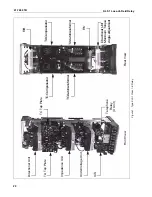
41-748.31B
6
KLF-1 Loss-of-Field Relay
The single-zone and two-zone setting recommenda-
tions are modified when two or more machines are
bussed at the machine terminals. The voltage and
time delay considerations are treated in detail in
other sections of this leaflet. The recommended set-
tings are outlined in Table 2.
5.2
IMPEDANCE UNIT
Set th e impe dance unit to operate befo re th e
steady-state stability limit is exceeded. Also, to allow
maximum output without an alarm, set the imped-
ance unit to allow the machine to operate at maxi-
mum hydrogen pressure and 0.95 per unit voltage
(lowest voltage for which the capability curve
applies). Where the maximum capability of the
machine cannot be realized without exceeding the
steady-state stability limit, set the impedance unit to
operate before the steady-state limit is exceeded.
Capability curves similar to Figure 7 (page 23) are
obtained from the generator manufacturer.
To determine the desired setting convert the capabil-
ity curve of Figure 7 to the impedance curve of Figure
8, by calculating
where V
T
is the per unit
terminal voltage and (kVA)
C
is the per unit output.
The angle of each point on the impedance curve is
the same angle as the corresponding point on the
capability curve.
For example, from Figure 7, an output of 0.6 per unit
kW on the 30# H
2
curve is -0.4 per unit reactive kVA.
T h e r e f o r e ,
per unit
and,
Converting to the impedance curve:
per unit
Since the angle remains the same, the impedance
plot conversion is:
, as shown in Figure 8 (page 23).
Continue this process with other points from curves
such as those of Figure 7 (page 23) until a complete
curve like that of Figure 8 (page 23) is obtained.
After plotting the steady-state stability limit and the
machine capability curves on the R-X diagram, plot
the impedance unit circle between the stability limit
and the capability curve. (Note in Figure 8 (page 23)
that the relay circle cannot be plotted within the 60# -
V
T
= 0.95 curve, since the machine is beyond the
steady-state stability limit for these conditions.) This
plot defines the desired reach Z
A
and radius R of the
relay circle. Then use the following procedure to
select tap settings.
where
Z
base
= one per unit primary ohms/as seen
from the relay
kV
= rated phase-to-phase voltage of
the machine.
kVA
= rated kVA of the machine.
R
C
= the current transformer ratio.
R
V
= the potential transformer ratio.
The actual settings, Z
A
and Z
C
are:
Z
A
= (Z
A
per unit) x (Z
base
)
Z
C
= (Z
C
per unit) x (Z
base
)
= (2R-Z
A
) x (Z
base
)
where R = radius of circle in per unit.
The tap-plate settings are made according to equa-
tions:
(5)
where:
T
= compensator tap value
S
= autotransformer primary tap value
M
= autotransformer secondary tap value
(M is a per-unit value determined by taking the sum
of the values between the L and R leads. The sign is
positive when L is above R and acts to lower the Z
setting. The sign is negative when R is above L and
acts to raise the Z setting).
The following procedure should be followed to obtain
an optimum setting of the relay:
V
T
2
k
VA
(
)
C
--------------------
kVA
(
)
C
0.6
(
)
2
0.4
–
(
)
2
+
0.721
=
=
Θ
tan
1
–
0.4
–
0.6
-----------
33.6
°
–
=
=
Z
V
T
2
kVA
(
)
C
-------------------
1.0
2
0.721
---------------
1.39
=
=
=
Z
1.39
33.6
°
–
∠
=
Z
base
1000
kV
( )
2
R
C
kVA
(
)
R
V
------------------------------------
ohms
=
Z
A
or
Z
C
(
)
TS
1
M
±
--------------
=





















